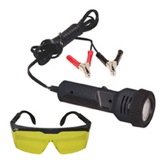Blog
Fluid leak detection with UV light

Car users do not normally look for leaks until they render the vehicle inoperative. Leaks are notoriously impossible to find with conventional methods, but they do result in expensive vehicle failures. Using a special leak detector, you can pinpoint the exact location of every leak in the vehicle's system, long before it becomes a costly proposition.
Fluid leak inspection also occurs during vehicle manufacturing and hot run tests. Most major diesel and gasoline vehicle engine manufacturers including forklift truck and earth moving equipment manufacturers use the UV inspection methods for detecting leaks.
This simple method utilizes only two parts. One is a high-intensity Blue/Ultraviolet or UV light lamp and the other is an appropriate Fluoro-Lite A/C fluorescent tracer dye or Dye-Lite fluid. You need to add the UV fluorescent dye to the fluid system and circulate it. The fluid system can be the vehicle's refrigerant, coolant, fuel, oil or water. Operate the vehicle as normal and allow the additive to circulate through the piping. Wherever there is a leak, the UV fluorescent tracer escapes along with the liquid and sticks to the site of the leak along the flow path.
Turn on the lamp and inspect your vehicle thoroughly. Check the underside of all external surfaces, joints, pipework, connectors, coils and gasket seals. As the dye collects at all the leak sites, it will glow brightly and you will be able to locate every leak and its flow path precisely as a bright fluorescent green/yellow glow. Usually, the new lights are LED types and come with a pair of fluorescence-enhancing glasses that help to detect the leak clearly.
You can also use this process for routine quality control or for occasional trouble shooting procedures as it offers a vastly improved method for detecting fluid leaks. A huge range of UV lamps for black light inspection is available. They incorporate HID or high-intensity discharge bulbs, LEDs and LP or low-pressure tubes as hand lamps and torches to light guide systems and large area flood lamps for detection fluid leaks.
UV light equipment should be selected based on a particular application. This will ideally be based on the area to be irradiated, the light intensity required, the integration process and the levels of ambient light available at the test site. Usually, the manufacturers provide recommendations for equipment selection along with health and safety training and products. This ensures that you get the maximum performance benefits, remain safe during use and are confident about detecting all types of leaks, however small.
For example, if you need to detect leaks in a small area such as in a single car, a 3W high-output Blacklight LED torch may be suitable. The lamp highlights a small area with its high-intensity long throw light easily revealing the fluid leaks in normal lighting. The torch has Nichia LED producing light of 365nm wavelength, is battery operated and rechargeable. It is a compact unit, light in weight, durable and waterproof up to IP 64.
For a medium sized area such as under a somewhat large vehicle, you may need to use a more powerful Blacklight torch. This could be the 35W high-intensity, long throw UV search light. It uses a 35W UV bulb that takes only 15 seconds to generate full UV light output and has a hot re-strike after 5 seconds. Being battery operated, the light is compact, lightweight, rechargeable and durable.
For inspecting areas under still larger vehicles, you will have to use a Blacklight 250W hand lamp. The High-Intensity discharge UV bulb provides easy revelation of leaking fluids in normal lighting; you do not need to blackout the area because of the excellent brightness of indication against a large background. The compact, lightweight and durable hand lamp illuminates a large area with UV irradiation and this reduces searching movements.

